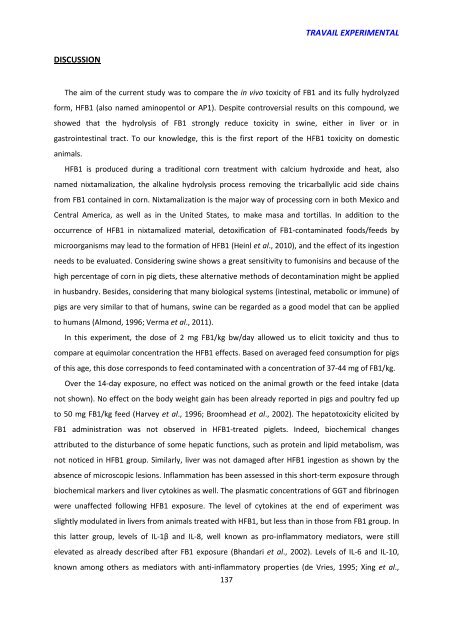Effet chez le porcelet d'une exposition à un régime co-contaminé en ...
Effet chez le porcelet d'une exposition à un régime co-contaminé en ...
Effet chez le porcelet d'une exposition à un régime co-contaminé en ...
You also want an ePaper? Increase the reach of your titles
YUMPU automatically turns print PDFs into web optimized ePapers that Google loves.
TRAVAIL EXPERIMENTALDISCUSSIONThe aim of the curr<strong>en</strong>t study was to <strong>co</strong>mpare the in vivo toxicity of FB1 and its fully hydrolyzedform, HFB1 (also named aminop<strong>en</strong>tol or AP1). Despite <strong>co</strong>ntroversial results on this <strong>co</strong>mpo<strong>un</strong>d, weshowed that the hydrolysis of FB1 strongly reduce toxicity in swine, either in liver or ingastrointestinal tract. To our know<strong>le</strong>dge, this is the first report of the HFB1 toxicity on domesticanimals.HFB1 is produced during a traditional <strong>co</strong>rn treatm<strong>en</strong>t with calcium hydroxide and heat, alsonamed nixtamalization, the alkaline hydrolysis process removing the tricarballylic acid side chainsfrom FB1 <strong>co</strong>ntained in <strong>co</strong>rn. Nixtamalization is the major way of processing <strong>co</strong>rn in both Mexi<strong>co</strong> andC<strong>en</strong>tral America, as well as in the United States, to make masa and tortillas. In addition to theoccurr<strong>en</strong>ce of HFB1 in nixtamalized material, detoxification of FB1-<strong>co</strong>ntaminated foods/feeds bymicroorganisms may <strong>le</strong>ad to the formation of HFB1 (Heinl et al., 2010), and the effect of its ingestionneeds to be evaluated. Considering swine shows a great s<strong>en</strong>sitivity to fumonisins and because of thehigh perc<strong>en</strong>tage of <strong>co</strong>rn in pig diets, these alternative methods of de<strong>co</strong>ntamination might be appliedin husbandry. Besides, <strong>co</strong>nsidering that many biological systems (intestinal, metabolic or imm<strong>un</strong>e) ofpigs are very similar to that of humans, swine can be regarded as a good model that can be appliedto humans (Almond, 1996; Verma et al., 2011).In this experim<strong>en</strong>t, the dose of 2 mg FB1/kg bw/day allowed us to elicit toxicity and thus to<strong>co</strong>mpare at equimolar <strong>co</strong>nc<strong>en</strong>tration the HFB1 effects. Based on averaged feed <strong>co</strong>nsumption for pigsof this age, this dose <strong>co</strong>rresponds to feed <strong>co</strong>ntaminated with a <strong>co</strong>nc<strong>en</strong>tration of 37-44 mg of FB1/kg.Over the 14-day exposure, no effect was noticed on the animal growth or the feed intake (datanot shown). No effect on the body weight gain has be<strong>en</strong> already reported in pigs and poultry fed upto 50 mg FB1/kg feed (Harvey et al., 1996; Broomhead et al., 2002). The hepatotoxicity elicited byFB1 administration was not observed in HFB1-treated pig<strong>le</strong>ts. Indeed, biochemical changesattributed to the disturbance of some hepatic f<strong>un</strong>ctions, such as protein and lipid metabolism, wasnot noticed in HFB1 group. Similarly, liver was not damaged after HFB1 ingestion as shown by theabs<strong>en</strong>ce of micros<strong>co</strong>pic <strong>le</strong>sions. Inflammation has be<strong>en</strong> assessed in this short-term exposure throughbiochemical markers and liver cytokines as well. The plasmatic <strong>co</strong>nc<strong>en</strong>trations of GGT and fibrinog<strong>en</strong>were <strong>un</strong>affected following HFB1 exposure. The <strong>le</strong>vel of cytokines at the <strong>en</strong>d of experim<strong>en</strong>t wasslightly modulated in livers from animals treated with HFB1, but <strong>le</strong>ss than in those from FB1 group. Inthis latter group, <strong>le</strong>vels of IL-1β and IL-8, well known as pro-inflammatory mediators, were stil<strong>le</strong><strong>le</strong>vated as already described after FB1 exposure (Bhandari et al., 2002). Levels of IL-6 and IL-10,known among others as mediators with anti-inflammatory properties (de Vries, 1995; Xing et al.,137

















